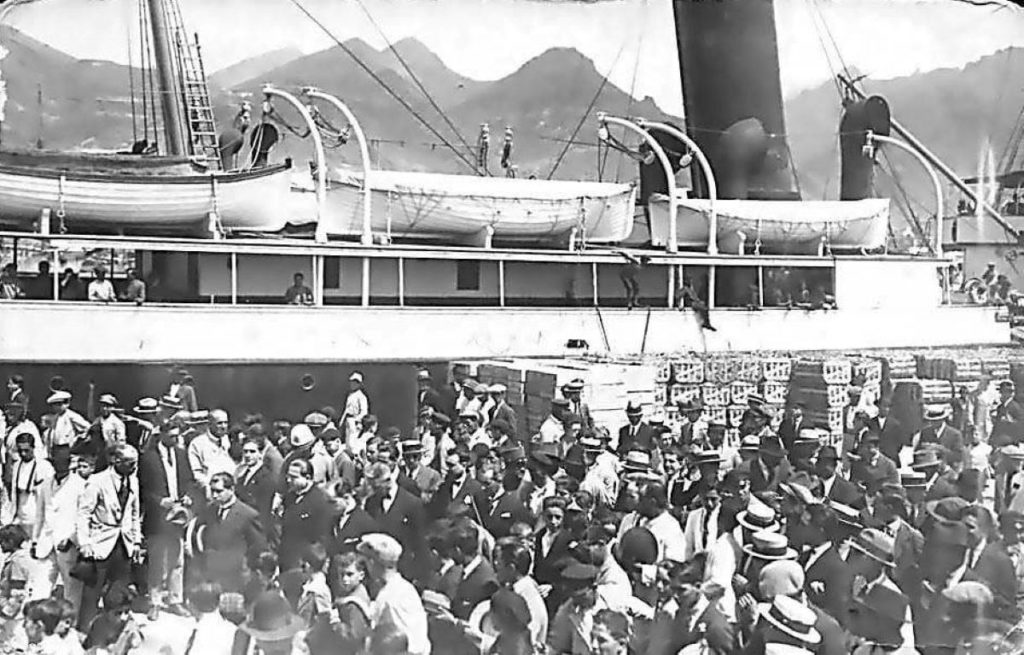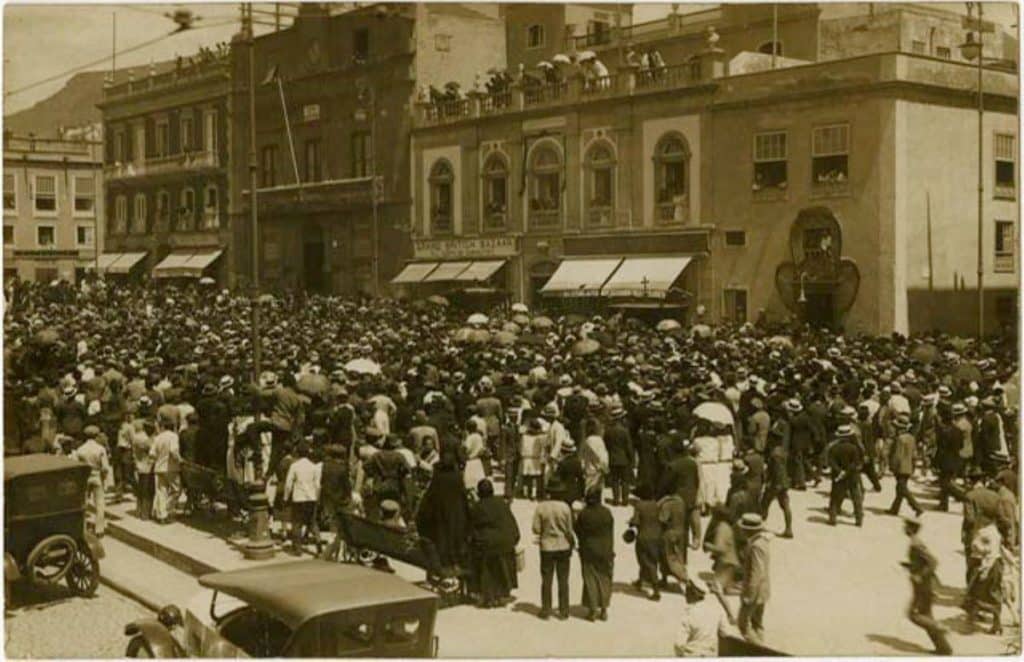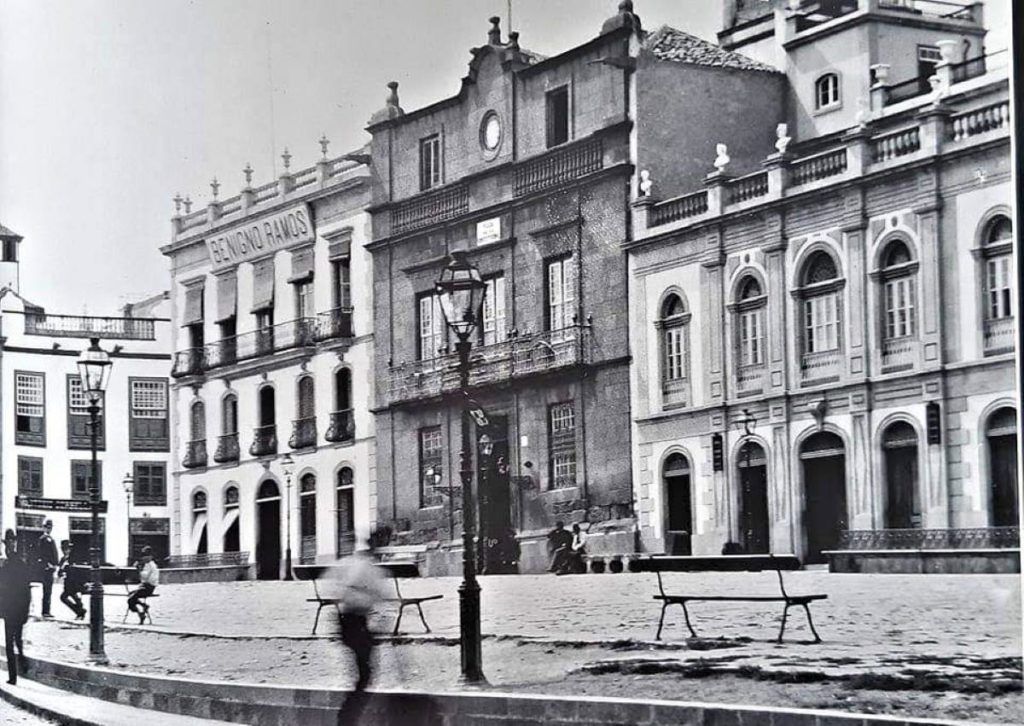By Juan Manuel Ledesma. Thirty-nine years after the death of the famous Tenerife musician Tybalt Power, the Madrid City Council allowed his mortal remains to be sent to Santa Cruz de Tenerife. He May 25, 1923at nine in the morning, the coffin arrived at the port of Santa Cruz, aboard the steam atlantean. Both the hearse that transported him and the other two that accompanied it were covered in wreaths and bouquets of flowers. Behind marched a large procession, chaired by the mayor, municipal corporation, civil, military, and ecclesiastical authorities, corporations, societies, official and educational centers, and so on.

The first stop took place in front of the house where the artist was born, in the Plaza de la Constitución -La Candelaria-, where the municipal band performed the Cantos Canarios. Then the procession continued through the streets of Alfonso XIII (Castillo), Valentín Sanz and Pérez Galdós, until it reached the Provincial Council –now the Parliament of the Canary Islands-, where a solemn act took place, attended by the aforementioned representations and a distinguished public that filled the hall and the upper galleries of the building.

From here he was transferred to the parish of Nuestra Señora de la Concepción, where he received a Christian burial in the chapel of Santiago. Since he disembarked at the pier, until he was buried, thousands of people, coming from all corners of the Island, paid him a heartfelt and multitudinous tribute.
The Madrid newspapers reported that, when the body was exhumed, and despite the almost forty years that had elapsed since his death, his hair and beard were still intact, and he was dressed in a tailcoat suit, white shirt, and patent leather shoes.
Therefore, 100 years have just passed since the arrival of the mortal remains of the famous musician on his native island. And that is a good excuse to remember him.
Teobaldo José de los Reyes y de la Concepción Power y Lugo-Viña was born in Santa Cruz de Santiago de Tenerife on January 6, 1848. He was the son of Bartolomé Power de Strickland y Arroyo, and Margarita de Lugo Viña y Oliver. His first years were spent around music, since his father -Civil Government official- amateur pianist, taught him his first musical knowledge; In addition, in front of his birthplace, located at number 9 of the Plaza de la Constitución -La Candelaria-, musical evenings used to be held, so from a young age he soaked up the concerts offered weekly by the orchestras and bands. chicharreras.

A precocious genius, at the age of nine he performed various pieces on the piano at an artistic evening held at the home of Nicolás Alfaro, an important musician and painter from Santa Cruz, where the attendees requested new interpretations up to six times. Presented at the Municipal Theater of Santa Cruz de Tenerife, on September 16, 1858, he interpreted a small composition of his (Polca Mazurca) and various themes by different composers. From this act, the press published: “How could a 10-year-old boy have been able to execute the works performed with such brilliance, mastery, security, cleanliness, and correct style if he did not reach the piano pedals with his feet.”
The following month, his father was assigned as a senior officer to the Barcelona Provincial Council, taking the entire family with him. In the city of Barcelona, Teobaldo began to study harmony and composition with the famous teacher Gabriel Balart. In December he offers a concert before the professors of the National School of Music and Declamation, in Madrid, and another in the Palace of the Infante Francisco de Paula, receiving praise from those present and from the specialized press.
When he was 14 years old, after having offered a concert at the house of the civil governor of Barcelona, which was attended by various authorities, the Catalan Provincial Council granted him a scholarship to further his studies at the Imperial Conservatory of Music and Declamation in Paris. . For four years (1862-1866) he will receive a solid musical training from prestigious teachers in harmony and composition, piano, counterpoint and fugue, receiving awards in all these areas. He also learned music didactics, a methodology that years later he would include in the study program of Spanish conservatories. In Paris he soaks up Chopin’s virtuosity and the inspiration of Liszt’s folklore and popular songs.
He spent the school holidays in the summer of 1864 in Tenerife where, on September 13, he premiered La Aurora, an overture for a large orchestra performed by the Santa Cruz Provincial Battalion Band.
From Madrid to Paris, Havana and Lisbon
After completing his studies in Paris, at just 18 years old, he began to travel constantly, without achieving professional stability. For three years he was acting in Havana (1866-1869), being decorated with the Cross of Military Merit. He returned to Paris again to direct an opera company, with which he toured France, until the Franco-Prussian war broke out (July 19, 1870) and he had to dissolve the company and move to Madrid, where he went to spend eight years of frenetic musical activity, but also financial difficulties, which forced him to work as a pianist in the El Prado and Imperial cafes, together with the violinist Fortuny. In this meeting place for artists, bohemians and intellectuals, he made friends with the poet Gustavo Adolfo Bécquer and with the musician Isaac Albéniz. These years were very fruitful for his musical career, as he began to be known and praised, being invited to give concerts at the Madrid and Paris Conservatories.
But this hectic bohemian, eccentric and adventurous life, which was so fruitful in his creation and his art, weakened his body, causing him a lung condition when he was 30 years old. His good friend, Tomás Zerolo, advised him to return to Tenerife, where he arrived on December 5, 1878, being welcomed by a group of intellectuals, who encouraged him to participate in a concert-tribute at the Municipal Theater, on December 15. March 1879; but, due to the abandonment that the musical art presented in the Archipelago, in order to carry it out he had to form an amateur orchestra; group of musicians that years later would form the Santa Cecilia Philharmonic Society.
On April 7, Teobaldo Power married his first cousin Julia González Lugo-Viña, who would accompany him until his death, and with whom he had no children.
Recovered from his state of health, he decided to travel to Lisbon where, after his resounding success at the Teatro San Carlos, King Luís de Braganza named him “Camera Pianist” inviting him to his palace where they both played, four hands, La Gallina de Gottschalk. In gratitude, years later Power dedicates a piano concert to him, inspired by airs from Tanganillo de Tenerife.
Back in Spain, he traveled to Malaga, where he gave several concerts but, feeling resentful of his illness, he decided to return to Tenerife, settling in a house on the Las Mercedes road, where the pure and healthy air of the mountains would cleanse his lungs damaged by his hectic life. In this bucolic place, encouraged by his friend Elías Zerolo, he began to investigate the couplets that he heard from the peasants in their daily tasks. In this way, the Cantos Canarios arose, the great musical poem that immortalized his name, since in them he put all his sensitivity, and the people all their longing and range of regionalist feelings.
Serious illness
Although he lived withdrawn and immersed in his healing and his art, from time to time he went down to La Laguna, along the old road to Las Mercedes, taking advantage of the shade of the Alameda del Tanque Grande -Camino de las Peras-, resting, on the way and around the corner, on the semicircular bench of La Cancela (Canapé Grande). Arriving in the city, he entered the El Porvenir casino – Palace of the Counts of Valle de Salazar, today the Bishopric of Tenerife, using his piano to complete the Cantos Canarios. On the threshold of death, gripped by his illness, the artist’s thoughts and soul transport him back to Valle de Las Mercedes and, with his trembling hand, he writes these lines to a friend: “Neither my triumphs, nor the undeserved applause with which the world receives my poor productions are enough to make me forget my beloved land, with that happy sky, that pure air and those steep rocks. I still do not lose hope of spending the last months of winter in Las Mercedes”. During this retirement, which lasted three years, he published several articles in the Revista de Canarias, entitled: The Orchestra, The Art of the Piano, and The Philharmonic Societies of Santa Cruz de Tenerife.
In the summer of 1956, the vacationers Álvaro Martín Díaz (Almadi) and Francisco Medina Martín considered it convenient that a plaque be placed in his memory in the house where the famous musician had recovered from his health. In April 1882, feeling restored to his health, he returned to the Peninsula to perform in Granada, Córdoba and Málaga, the city where he was appointed professor at the Conservatory. In October of that year, he won the opposition for piano teacher at the Madrid Conservatory, against eleven prestigious competitors, and also obtained the position of second organist at the Royal Chapel.
Two years later, when he was at the height of his career, his prestige and fame had been consolidated as a composer, performer, and teacher, his students won first prizes, publishers published his works, and orchestras premiered his symphonic music. , the lung disease he suffered worsened, and he died on May 16, 1884, at his home on Calle de la Reja, No. 1 in Madrid, at only 36 years of age. His death was a great mourning. The coffin was carried on the shoulders of his students and teachers from his house to the National School of Music, where he was exposed and honored with a multitude of wreaths. He was also carried on shoulders to the Sacramental of San Lorenzo and San José, a cemetery located in Carabanchel.
The legacy that Power left us as a memory and tribute to his land are the Cantos Canarios, a beautiful, cultured and symphonic piece of music, with brilliant and varied instrumentation that, orchestrated, can be considered a symphonic poem, in which the following folkloric airs follow one another. : Song of the herdsman, Arroró, Tajaraste, Folia, Malagueña, Seguidilla, Isa and Tanganillo. These harmonies, wherever we hear them, bring us the image of the earth and awaken memories in us, because in them we hear from the deep song with which our mother lulled us in the cradle, to the lively and joyful sound of the most joyous of island dances.
The Cantos Canarios were presented in a tremendous way on August 5, 1880, on the occasion of the inauguration of the Santa Cecilia Philharmonic Society, current seat of the Parliament of the Canary Islands. The orchestra was conducted by Power himself. At the end of the concert, to the cheers and applause of the attendees, the composer was presented with a laurel wreath, which he thanked with emotion. Unfortunately, the original score has been lost. The Cantos Canarios were presented in Madrid on June 6, 1883 by the Unión Artística Musical, directed by maestro Bretón.
The first version for symphony orchestra was performed by Don Santiago Sabina Corona (Santa Cruz de Tenerife 1893-1966), the first conductor of the Tenerife Symphony Orchestra (1935-1966), and the most modern version has been made by Peter Hope (1930). , British composer and arranger.
Also, Braulio Uralde Bringas (1864-1915) made a version for Banda, during his stage as 4th director of the Municipal Band of Santa Cruz de Tenerife (1913-1915).
Since April 28, 2003, the Official Anthem of the Canary Islands is the Arroró, a composition taken from the Cantos Canarios by Teobaldo Power.















